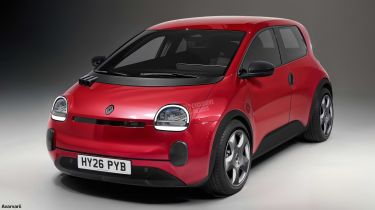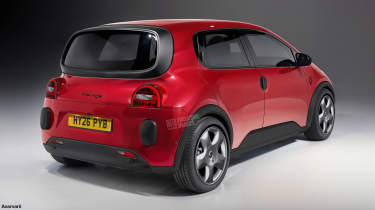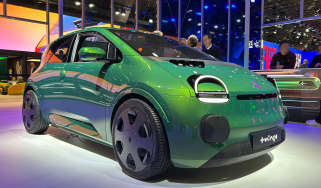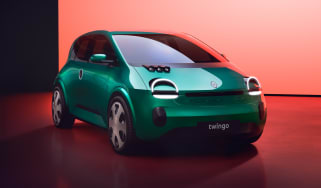New Renault Twingo EV taking shape ahead of 2025 reveal
Our exclusive images show how the new baby Renault Twingo EV could look, as design chief discusses the concept that previews it
An all-new Renault Twingo EV will form the final piece of the French brand’s small-car puzzle when it’s revealed next year. While the production model is said to be “90 per cent” true to the concept, subtle differences – previewed by our exclusive images – will ensure the city car comes in under its mooted 20,000 Euros (£17,000) starting price.
We caught up with the man in charge of Renault concept car design, Sandeep Bhambra, who told us the upcoming new Twingo will need to be as “minimalist as possible” in order to make it as “timeless as possible”.
He said the original Twingo – first shown in 1992 – was designed as a “car to live in”. While at the time it rivalled small hatchbacks like the Ford Fiesta, Vauxhall Corsa and Nissan Micra, Renault considered it more as a relative of the Espace – and saw it as the firm’s smallest MPV.
At just 3.75 metres long, the new Twingo will undercut the Renault 5 in both size and price. But it’ll still have a practical five-door body, with the wheels pushed out to the corners to maximise passenger room.
Like the R5, the Twingo is expected to sacrifice boot space to make it more comfortable for those inside: “It is for a family, in the sense that you can get your kids in,” Bhambra told us.
The familiar overall shape is made possible by the firm’s AmpR Small platform, which the Twingo will share with the Renault 4 and 5. “We moved away from the mono-volume shape for the second and third-generation [Twingo],” Bhambra told us. “But now that we have the AmpR platform – a native EV platform – it allows us to make it mono-volume again.
“All the key components are in the floor, between the wheels; it’s a long wheelbase – around 2.5 metres. At the front we have electronics, but all of it is very low. With this we can still meet crash and pedestrian impact [regulations], but with a mono-volume shape,” he said.
Given how close the concept is to reality, we expect only a mild dilution of key features when the covers come off. The animated logo will be the first part binned, however: “The Twingo is going to be sold for 20,000 Euros,” Bhambra told us. “That is quite low for an EV, so probably that logo will not make it in production”.
We’ll likely see a simplification of the sharp LED lights front and rear, too. The bell shape will remain, but possibly with halogen elements to reduce complexity and cut the cost of replacement. Plenty of scuff-resistant black cladding will feature around the base of the car, and we may even see Renault carry over the bump stops on each corner of the concept – this is a car designed to cope with Paris parking, after all.
Other details, like the three-slot air vent on the bonnet, will reach production almost unchanged. This, Bhambra explained, feeds the air-conditioning system and is a necessary nod to the original nineties design.
He said the concept’s door handles might be hard to replicate, however. “There is a possibility of pinching yourself when opening the door,” he told us. “So it’s quite difficult to put this door handle into production.”
There’s still a strong chance Renault will give the new handle the look and feel of the original, but with small tweaks. In addition, it’s likely that designers will look to hide the rear door opening in the C-pillar, as on the R5 – not only for aesthetic reasons, but also to reduce stamping costs thanks to the cleaner surfacing.
Given the car’s predicted starting price, we expect the Twingo to use a pared-back version of the R5’s interior, possibly with smaller displays. Renault may even offer base versions with a phone holder in place of the centrally mounted touchscreen to cut costs.
It’s highly likely, though, that the French maker will use lessons learned from the 4 and 5, by filling the cabin with fabric panels. These will cover key components such as the doors and dashboard to disguise any cost-cutting plastics that may otherwise align with the Twingo’s budget billing.
At several points, Bhambra seemed keen to reiterate the next Twingo’s market position: “It is for the family, but it’s more for doing a run around the city, instead of taking the highway or going on vacation,” he said.
This, he added, will be reflected in the car’s specifications – suggesting the Twingo may launch only with the smaller of the two batteries in the R5. There, the 40kWh unit offers a range of 186 miles, although the lighter Twingo might stretch that to 200.
“We have a very specific use case [for Twingo],” Bhambra told us. “This gives us a very specific battery size, a very efficient weight target. Then you have something virtuous to drive as an urban object. Whereas if you try to do more things with one car, then you build on more weight, and more battery, and more constraints.”
Assuming other parts are carried over unchanged, we can expect a 100kW maximum charge speed – good for a 10 to 80 per cent top-up in around half an hour. The smaller-battery 5 uses the less powerful front-mounted motor producing 93bhp – suggesting even the base Twingo should be good for 0-62mph in 10 seconds.
Renault hasn’t confirmed whether it will offer the Twingo in the UK, but the new electric car could take on cars like the new Citroen e-C3 and Fiat Grande Panda, plus a slew of rivals from China. We expect a decision next year, before production starts in 2026.
Click here for our list of the best small electric cars...








